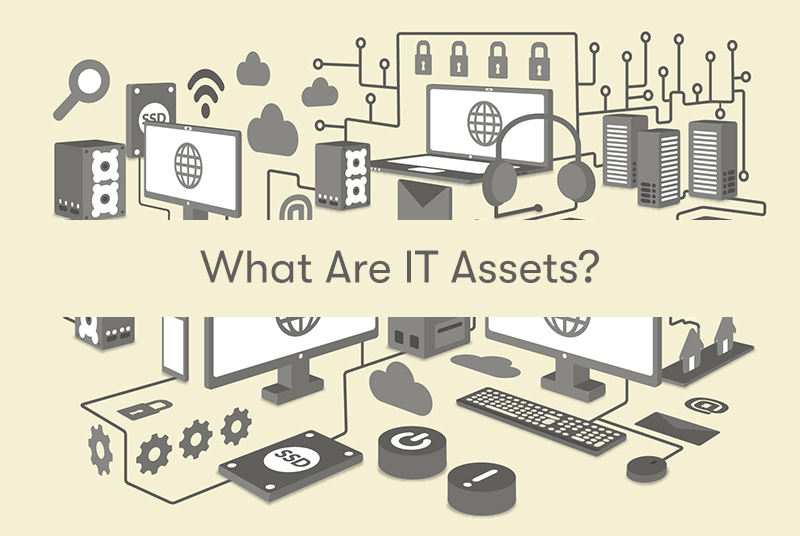What Are IT Assets?
Welcome to our in-depth exploration of IT assets, a fundamental aspect of modern organisational infrastructure. In today's technology-driven business landscape, understanding what constitutes an IT asset is crucial. IT assets encompass many components, from tangible hardware like computers and servers to intangible elements like software and data. These assets form the backbone of any organisation's technological capabilities, driving efficiency and enabling innovation.
As we delve into the various types of IT assets, including hardware, software, digital data, network resources, and cloud-based services, we will uncover their significance in the overall IT ecosystem. Our journey will highlight not just the diversity of these assets but also the importance of their effective management for achieving strategic business objectives and maintaining a competitive edge in the digital era.
What is an IT Asset?
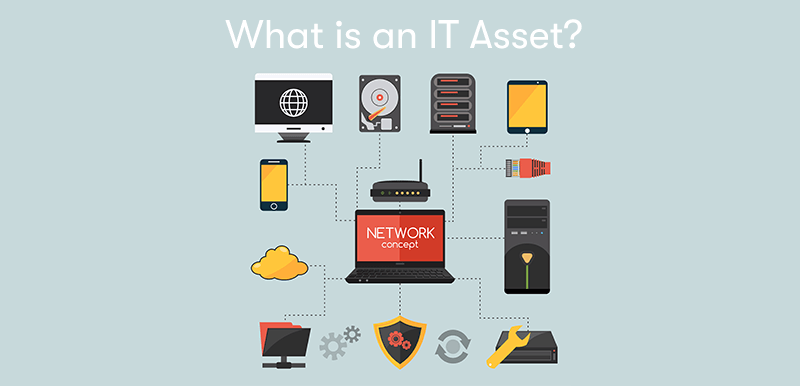
An IT (Information Technology) asset is a broad term that encompasses various components essential to an organisation's technological infrastructure and operations. The company owns these assets, which are integral in supporting business activities. They can be categorised into several key types:
Hardware Assets
These are tangible, physical devices used in an organisation's IT environment. This category includes desktop computers, laptops, and servers, which are essential for processing and storing information, as well as peripherals like printers, scanners, and external hard drives. Networking equipment such as routers, switches, and wireless access points also fall under this category. These devices facilitate internal and external communication and data transfer.
Software Assets
This category includes all the software applications and operating systems that run on the organisation's hardware. It encompasses a range of products, from office productivity suites like Microsoft Office to specialised enterprise applications such as customer relationship management (CRM) and enterprise resource planning (ERP) systems. Software licenses, which grant the right to use these software applications, are also considered critical IT assets.
Data Assets
Perhaps the most valuable of all IT assets, data assets include the vast amounts of information businesses collect, store, process, and analyse. This can range from customer databases, financial records, and intellectual property to emails, documents, and spreadsheets. Effective data management ensures data integrity, security, and accessibility.
Network Resources
These assets encompass the various components of an organisation's network infrastructure. This includes physical hardware like routers and switches and the software systems that manage network traffic, security protocols like firewalls, and bandwidth and connectivity solutions (such as leased lines or broadband connections) that enable data flow within and outside the organisation.
Mobile Devices
In today's mobile-centric world, assets like smartphones, tablets, and other portable devices are crucial for business operations. They enable employees to work remotely and stay connected while on the move. Managing these devices involves ensuring they are secure, up-to-date, and aligned with company policies.
Cloud Resources
With the rise of cloud computing, assets like cloud storage space, virtual servers, and cloud-based applications have become essential components of many organisations' IT strategies. These resources offer scalability, flexibility, and often cost savings, but they also require careful management to ensure security and optimal utilisation.
Managing these IT assets is a complex process involving tracking and overseeing each asset's entire life cycle. This includes the procurement process, deployment, regular maintenance, updates, and the eventual decommissioning or replacement of the assets. Effective IT asset management is crucial for maintaining operational efficiency, ensuring cybersecurity, optimising costs, and supporting strategic business decisions.
What Types of IT Assets Do You Need to Consider?
In Information Technology Asset Management (ITAM), it's essential to consider a comprehensive range of IT assets to ensure efficient management, cost control, and compliance. The types of IT assets typically included in ITAM can be broadly categorised as follows:
Hardware Assets
- Computing Devices: This includes desktops, laptops, servers, and workstations.
- Networking Equipment: Routers, switches, modems, and wireless network devices.
- Storage Devices: External hard drives, NAS (Network Attached Storage) devices, and SAN (Storage Area Network) systems.
- Peripheral Devices: Printers, scanners, monitors, and projectors.
- Mobile Devices: Smartphones, tablets, and other portable devices.
- Other Hardware: This can include specialised equipment like POS (Point of Sale) systems, IoT (Internet of Things) devices, and any other hardware used in business operations.
Software Assets
- Operating Systems: The foundational software that runs on all computing devices.
- Applications and Utilities: Productivity software, enterprise applications (like CRM and ERP), security software, and other utility programs.
- Software Licenses: Documentation and records related to the usage rights, limitations, and terms of the software used by the organisation.
- Cloud-based Applications: Software as a Service (SaaS) applications and platforms.
Digital Assets
- Data: Business data, including customer information, financial records, employee data, and proprietary business information.
- Websites and Domains: Owned web properties and associated domain names.
- Multimedia Content: Digital media such as images, videos, and audio files are used for business purposes.
Network Resources
- Network Infrastructure: Physical and virtual components of the network architecture.
- Telecommunications Systems: Includes VoIP systems and other telecommunication setups.
- Internet Connectivity and Bandwidth: Contracts and agreements related to Internet service provision.
Cloud Resources
- Cloud Storage and Computing Services: Includes IaaS (Infrastructure as a Service), PaaS (Platform as a Service), and other cloud-based services.
- Cloud Software Subscriptions: Recurring subscriptions for cloud services.
- Virtual Machines and Containers: Used in cloud or on-premises environments.
Service and Maintenance Contracts
- Warranties and Support Agreements: Documentation and records of IT asset service level agreements, warranties, and maintenance contracts.
Documentation and Configuration Files
- Configuration Files: Files that detail the setup and configuration of software and hardware.
- User Manuals and Technical Documentation: Guides and manuals for IT assets.
Considering these varied types of IT assets is crucial for comprehensive ITAM. This process helps track and manage physical and digital assets and plays a vital role in strategic planning, financial management, risk management, and compliance with legal and regulatory standards. Effective ITAM ensures that the IT assets are utilised efficiently, optimally, and securely, contributing to the overall success and resilience of the organisation.
What Are Some Examples of These Assets?
Here are specific examples for each category of IT assets to illustrate what might be included in a comprehensive IT Asset Management (ITAM) program:
Hardware Assets
- Computing Devices: Dell Latitude laptops, Apple MacBooks, HP ProLiant servers.
- Networking Equipment: Cisco routers, Netgear switches, Ubiquiti wireless access points.
- Storage Devices: Western Digital external hard drives, Synology NAS systems, EMC SAN.
- Peripheral Devices: HP LaserJet printers, Epson scanners, Samsung monitors.
- Mobile Devices: Apple iPhones, Samsung Galaxy smartphones, iPad tablets.
- Other Hardware: Verifone POS systems, Raspberry Pi for IoT projects.
Software Assets
- Operating Systems: Microsoft Windows 10, macOS Big Sur, Linux Ubuntu.
- Applications and Utilities: Microsoft Office 365, Adobe Creative Cloud, McAfee Antivirus.
- Software Licenses: Oracle database licenses, Autodesk AutoCAD licenses.
- Cloud-based Applications: Salesforce CRM, Slack for team communication, Zoom for video conferencing.
Digital Assets
- Data: Customer databases, financial transaction records, employee personnel files.
- Websites and Domains: The company's main website and online retail domains.
- Multimedia Content: Marketing videos, product images, and corporate training materials.
Network Resources
- Network Infrastructure: Fortinet firewalls, VMware virtualisation software.
- Telecommunications Systems: Avaya VoIP phones, Cisco Unified Communications Manager.
- Internet Connectivity and Bandwidth: Business broadband from Comcast AT&T fibre-optic lines.
Cloud Resources
- Cloud Storage and Computing Services: Amazon Web Services (AWS) EC2 instances, Google Cloud storage.
- Cloud Software Subscriptions: Dropbox Business for cloud storage, Microsoft Azure services.
- Virtual Machines and Containers: Docker containers, Microsoft Hyper-V virtual machines.
Service and Maintenance Contracts
- Warranties and Support Agreements: AppleCare for MacBooks, Dell ProSupport for servers.
Documentation and Configuration Files
- Configuration Files: Network configuration files for Cisco routers.
- User Manuals and Technical Documentation: User manuals for software applications hardware setup guides.
These examples cover a broad range of IT assets, from commonly used office hardware and software to more specialised IT infrastructure and services. Effective management of these assets is crucial for optimising their use, ensuring security, and aligning IT resources with the organisation's business goals.
What is IT Asset Management (ITAM)?
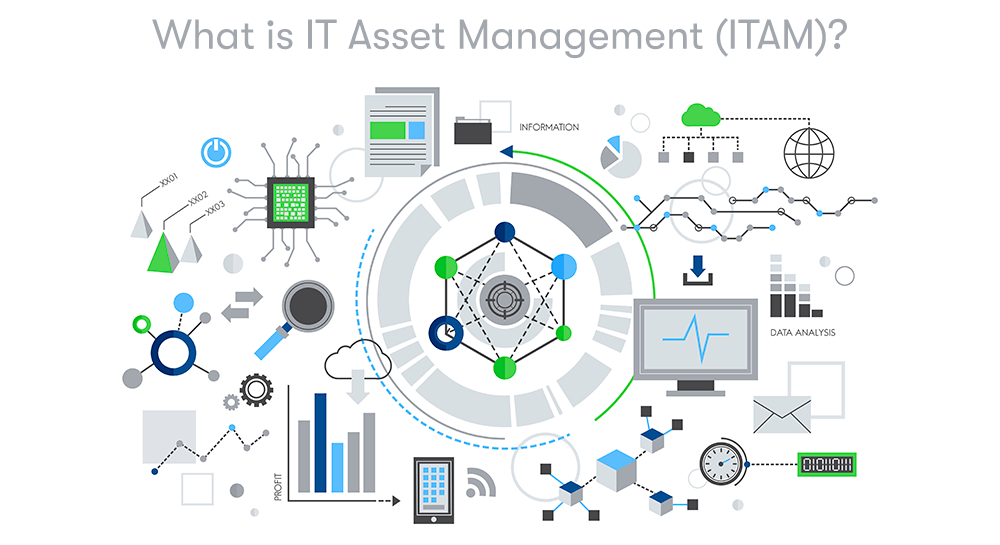
IT Asset Management is a set of business practices that involves managing and optimising the acquisition, deployment, maintenance, utilisation, and disposal of information technology (IT) assets within an organisation. The primary goal of ITAM is to oversee the lifecycle of IT assets to ensure they contribute to the organisation's business value as effectively as possible. Key aspects of ITAM include:
Asset Lifecycle Management
Track and manage IT assets throughout their entire lifecycle, from procurement or creation to disposal. This process involves planning for the acquisition, deployment, operation, maintenance, upgrading, and eventual disposal or replacement of IT assets.
Financial Management
Managing the costs associated with IT assets, which includes the initial purchase, ongoing maintenance, and operational expenses. ITAM helps make informed decisions on purchasing, leasing, or disposing of assets, ensuring cost-effectiveness and return on investment (ROI).
Inventory Management
Keeping an accurate and up-to-date inventory of all IT assets. This includes hardware and software, licenses, warranties, and service agreements. Effective inventory management helps in reducing the risks of over-purchasing or underutilising assets.
Contract Management
Managing contracts associated with IT assets, such as software licenses, service agreements, lease agreements, and maintenance contracts. This ensures compliance with legal and regulatory requirements and helps avoid penalties for non-compliance or overuse of software licenses.
Risk Management
Identifying and managing risks associated with IT assets. This includes addressing security vulnerabilities, ensuring data protection, and maintaining disaster recovery and business continuity plans.
Compliance Management
Ensuring the organisation complies with various legal, regulatory, and contractual obligations related to IT assets. This includes software license compliance, adherence to data protection regulations, and ensuring that hardware disposals are environmentally compliant.
Strategic Planning
Aligning IT asset management with the organisation's overall business objectives and strategies. ITAM provides critical information for strategic decision-making, such as technology investments, resource allocation, and IT infrastructure changes.
Performance Monitoring
Regularly reviewing and analysing the performance and usage of IT assets to ensure they are being used optimally and efficiently.
Effective ITAM not only helps reduce costs and optimise asset use but also plays a critical role in enhancing operational efficiency, improving service delivery, and supporting overall business objectives. It requires a combination of processes, policies, and tools and often involves collaboration across various organisational departments.
Why is Managing IT Assets Important?
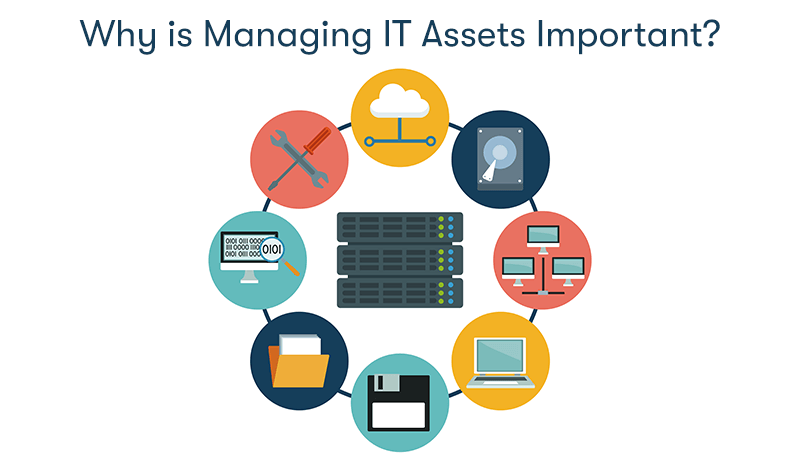
Managing IT assets is crucial for several reasons, each contributing to the overall efficiency, security, and financial health of an organisation:
Cost Optimisation
Effective IT asset management helps in controlling and reducing costs. By accurately tracking assets, companies can avoid unnecessary purchases, leverage volume discounts, and manage software licenses more efficiently. It also helps identify underutilised assets that can be reallocated or disposed of, thus reducing waste.
Compliance and Legal Risks
Proper management of IT assets ensures compliance with various laws, regulations, and contractual agreements. For instance, software license management is essential to avoid legal issues related to under-licensing or piracy. Additionally, compliance with data protection regulations like GDPR is crucial for managing digital assets.
Security and Risk Management
Knowing your assets and where they are is key to securing them. ITAM helps identify vulnerabilities and ensure that all assets are appropriately patched and updated and that obsolete systems are securely decommissioned. This reduces the risk of security breaches and data loss.
Strategic Planning and Decision Making
ITAM provides valuable data that aids in strategic IT planning. By understanding the lifecycle of assets, organisations can plan for replacements and upgrades, ensuring that the IT infrastructure aligns with long-term business goals.
Enhanced Productivity and Efficiency
Well-managed IT assets are less likely to fail and cause downtime. Regular maintenance and timely upgrades ensure employees have the tools to work effectively. Moreover, reallocating underutilised assets can improve overall organisational efficiency.
Inventory and Lifecycle Management
Keeping track of IT assets throughout their lifecycle – from procurement to disposal – helps in making informed decisions about when to upgrade or retire assets. It also aids in inventory control, preventing loss or theft of assets.
Support and Maintenance
Efficient ITAM helps manage warranties, service contracts, and maintenance schedules, ensuring that IT assets are well-supported and maintained, extending their useful life and reliability.
Environmental Responsibility
Proper disposal or recycling of IT assets as part of ITAM is a regulatory requirement in many cases and a part of corporate social responsibility. It ensures that e-waste is handled in an environmentally friendly manner.
Better Service Delivery
For IT departments, having a clear picture of the available assets allows for more efficient and practical support and service delivery to end-users.
Financial Reporting and Forecasting
ITAM provides accurate data for financial reporting on IT expenditures and assists in forecasting future IT investment requirements.
What Are Asset Tags?
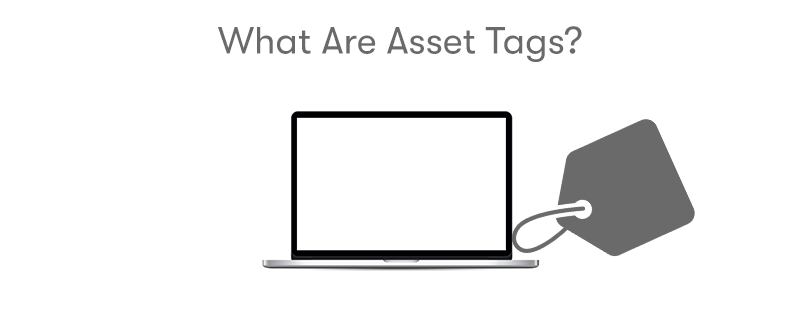
Asset tags are physical labels used to identify and track IT assets within an organisation. They are a crucial component of ITAM and play a significant role in maintaining the inventory of assets. Here's a detailed overview of asset tags:
Purpose of Asset Tags
Asset tags help track and manage assets throughout their lifecycle. They are used for inventory management, theft prevention, maintenance tracking, and ensuring accurate record-keeping for audits and compliance.
Types of Asset Tags
- Barcode Asset Tags: These contain a barcode that can be scanned to retrieve information about the asset. They are widely used due to their simplicity and cost-effectiveness.
- QR Code Tags: Similar to barcodes but can store more information. QR codes can be scanned using smartphones, making quick access to asset information convenient.
- RFID (Radio-Frequency Identification) Tags: These use radio waves to communicate asset information. RFID tags can be read from a distance, allowing quick inventory checks without needing direct line-of-sight.
- NFC (Near Field Communication) Tags: Similar to RFID but designed for closer proximity reading and often used for assets that require secure, close-range interaction.
- Magnetic Strips: Used in swipe-card systems, these tags are typically found in security or access control assets.
- Materials and Durability: Asset tags are made from various materials like paper, plastic, metal, or tamper-evident and weather-resistant substances, depending on the required durability and the environment where they will be used.
Information on Asset Tags
Typically, asset tags display a unique identifier (like a serial number) that links to a record in the asset management database. This record can contain information like the asset's purchase date, specifications, location, user, maintenance history, and warranty details.
Usage and Placement
Asset tags are affixed to various IT assets like computers, servers, monitors, phones, and other equipment. The placement is usually in an easily accessible and visible area but not where it might interfere with the asset's use or be prone to wear and tear.
Benefits
- Improved Asset Tracking: Easier to keep track of where assets are located and how they are being used.
- Maintenance and Upgrades: Simplifies tracking maintenance schedules and upgrade cycles.
- Theft Deterrence and Recovery: Provides a way to identify and recover stolen assets.
- Audit and Compliance: Facilitates asset audits and ensures compliance with regulatory requirements.
- Cost Management: Helps manage costs by preventing asset loss and optimising usage.
Integration with ITAM Systems
Asset tags are often integrated with IT asset management software, where scanning the tag can bring up the asset's entire history and current status in the management system.
Asset tags are a simple yet powerful tool for maintaining control over an organisation's assets, ensuring efficient use, and supporting overall asset management strategies.
Final Notes on IT Assets
In conclusion, understanding and effectively managing IT assets through IT Asset Management (ITAM) is essential for any organisation aiming to optimise costs, enhance operational efficiency, and ensure compliance with legal and regulatory standards.
From hardware and software to data and cloud resources, each IT asset plays a crucial role in the broader technology ecosystem of a company.
Utilising tools like asset tags simplifies tracking and maintaining these assets, reinforcing the importance of a robust ITAM strategy. As we've explored, ITAM is not just about keeping an inventory; it's about strategically aligning IT resources with business objectives, managing risks, and securing assets.
In the ever-evolving landscape of technology, the careful management of IT assets remains a cornerstone of organisational success and resilience.


